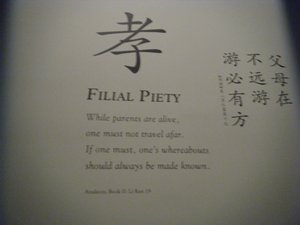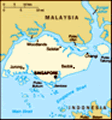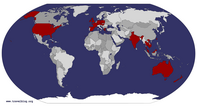Advertisement
Published: February 24th 2010

 Filial Piety
Filial Piety
It's a good thing I am not a follower of Confucian thought or I wouldn't be here.When most Americans my age or older think of Singapore, they remember the 1994 incident involving American Michael Fay. While traveling in Singapore, 18 year old Michael got himself into trouble for theft and vandalism and was subject to getting caned (essentially whipped on the rear by a rattan cane) six times. Bill Clinton intervened and the sentence was reduced to four lashes.
My lewd and unruly behavior at times gave me great pause when entering the city. If things like chewing gum and jaywalking are illegal and subject to immense fines, I can only imagine the penalty for some of my tendencies.
Singapore lies within the Malay portion of the world, a land of islands at the midpoint of monsoon winds. The monsoon winds, blowing from the northeast the first part of the year and from the southwest the latter part, made this part of the world a center for trade between China, India, Arabia and, eventually, Europe. The area was full of rugged terrain and dense forests, making it thinly populated, except in centers of economic activity, such as Singapore.
With the extent of trade that has existed in the area for two thousand years, Singapore

 Lunch
Lunch
My lunch in Little India.naturally became an ethnic melting pot. As the hostel’s proprietor, Andrew, told me last night, the Chinese comprise the largest portion of the mix at about three quarters, though this has dwindled by about 10% over the last 10 years. The city-state also includes a lot of people of Indian and Arabic descent, along with Malays. Adding to this, Singapore was once colonized under Great Britain, so among all these diverse cultures there remains a strong British influence.
In this land so far away from home and, at first glance, so seemingly different, I felt surprisingly at home. Perhaps it’s having lived near Chinatown in New York City and seeing the cultural melting pot that New York City offers. Singapore had a far less foreign feel than I would have thought. Communication was even primarily in English, with more traditional languages spoken only among friends and family, like Spanish, Chinese or any foreign language in American cities.
I started off the morning with breakfast outside as I reviewed my itinerary for the day and found everything on my map. I would have a very busy day ahead of me. Lingering in the air was the pungent yet delectable

 Market
Market
Much of the goods for sale at the street market were a bit old by US standards.aroma of Chinatown’s food stalls coming alive.
I started off my touring in Chinatown, taking in the street markets and the remaining decorations from the recently celebrated Chinese New Year. I also went in Sri Mariamman Temple, having to remove my shoes before entering - which, incidentally, I had to do at the hostel last night, too.
As I wandered about, the locals were very interested in me; the vendors probably seeing me as a wealthy target. A few asked “Where you going?” or “Where you from?”, something that was suggested in my Asia book as a greeting similar to our saying “What’s up?” - not to be taken literally. Still, I at least acknowledged my being an American. One person even noticed me consulting my map and was more than willing to assist me if I were lost.
I left Chinatown and proceeded up past the Parliament House and Supreme Court in the busy business district on my way to the 150 year old government building which now houses the Asian Civilizations Museum.
A product of a country that focuses on a western civilizations based history, in both grade school and college, I have an

 Singapore Sling
Singapore Sling
The most expensive drink I've ever bought.infinitesimally small basis in Asian history. And I don’t blame the system - it would be impossible to cover millions of years of history across the globe in the span of a few years for only an hour or so a day. Asia, as it was farthest away and had less to do with our past than other parts of the world, was a vast part of what was omitted.
The Asian Civilizations Museum provides a broad perspective of Asian cultures and civilizations. I had also hoped that touring it would fill in my lacking foundation of basic Asian history.
Besides what I was able to depict above, I learned very little about Asia‘s history. The bulk of the tour was on the artwork and artifacts used to establish the history, with little mention of the history it established. Yet with no real perspective the meaning and significance of these went largely unappreciated.
As the tour guide spoke of the intricacies of some ancient Asian cultures I found myself looking at some of the signage that gave a broader perspective. I checked back in at one point, just in time to learn of the Confucian belief in

 Merlion
Merlion
The giant Merlion at Merlion Park.Filial Piety - that children are responsible for their elders. Surely this isn’t too different within our society, especially as people reach their golden years. What hit home for me was a projection that said that even “while parents are alive, children should not travel afar.” Well, so much for being a good son.
Throughout the tour we covered Southeast Asia, China, Hinduism, Daoism, South Asia (mainly India), Buddhism, West Asia (more less Pakistan, Afghanistan and a few smaller countries nearby) and Islam. Of all this, the most interesting aspect was the virtual creation of a mosque, with the front walls of five famous mosques projected onto a screen.
Still lacking in Asian history, I decided it would be a good idea to find a book on the subject. It would have to be very basic to cover such a vast region and period of time without becoming too sizable to carry. I checked in the museum, where there was one book that could have worked but it still seemed a bit dense for my purpose. I also stopped at a used book shop on the way to Little India but all they had were textbooks covering the

 Thian Hok Keng Temple
Thian Hok Keng Temple
Inside Thian Hok Keng Temple.last couple hundred years. I’ll have to keep looking.
My next stop was Little India, a section of Singapore that is entirely different from the rest. I entered the area by a large section of clothing and jewelry shops. I was immediately greeted by Raj, who insisted I come inside his “family run” store. I imagine that family run is used a bit loosely in the same sense as me calling a friend “brother”.
Inside, I met a few of Raj’s
brothers, each of which offered to make me very fine suits, shirts, trousers or anything other form of clothing I want. I expressed my not being interested but, undeterred, they insisted I pick up some silk scarves for my lady friends back home.
This happened a few times during the day. I relished it as part of the experience though I didn’t buy a thing. For those less adept at avoiding impulse buys I would recommend being wary. They are excellent salesmen who, like crocodiles at the edge of the water, like to pick off unsuspecting tourists by pulling them into their domain where they clearly are the dominant party. But if you are interested in

 Chinatown
Chinatown
Chinatown is filled with street markets.shopping and have the means of carrying purchases with you, some of the garments did look nice and were priced much better than at home for a custom made job.
I stopped for lunch at Sakunthala‘s Food Palace, which was recommended in a travel guide as a very unique Chinese-Indian fusion restaurant. I went in and ordered a meal of chicken masala with a few different vegetable sides, copious amounts of rice, very thin naan bread and some sauces. The waiter brought out napkins and cutlery while I waited for the food to be prepared.
Looking around, I quickly discovered that the cutlery wouldn’t be necessary. All the other customers were obviously locals of Indian descent who used their hand (specifically their right hand) to eat. Not just for the bread but everything. I looked to my right and saw three ladies carefully mixing the sauces into their rice. Each, cupping her right hand, would scoop up a bite sized portion of rice and use the hand in lieu of a spoon. Everyone was doing this, not worrying about the appearance of their hand.
Not being one to go against the grain of so interesting a custom

 McDonald's
McDonald's
If a place doesn't have a McDonald's does it really exist?- and to finally get to use my hands when eating without being condemned or considered a slob - I joined in when my meal arrived. By the end my hand was a mess. I found traces of sauce as far up on my right arm as my elbow. It was so much fun.
The meal itself was very enjoyable, with more use of fresh vegetables and less of a cream sauce than what I’m used to in even the best of Indian food in America. It certainly wasn’t the tastiest Indian food I’ve had but it was close.
I used all the napkins they gave me to clean up and headed back out for some more exploring. Still in Little India, I came upon another restaurant that at which, had I not just ate, I’m convinced I would I would have dined. On the wall there was a set of ten wooden boards spaced just an inch apart with writing on them; each board proclaiming a level of chilli heat. Next to each of the boards were strings with clothespins, each clothespin representing a guest who could handle that level of heat.
I spoke with one

 Bill Clinton
Bill Clinton
Get your hand shaken = he bought a suit here. And you should, too!of the workers about it and he mentioned that they do a test before they even let you go past level six, with few people passing. If you pass that, you are free to choose a dish from any of the upper levels. No one has ever finished level 10 (We Declare You King) and only one passed level nine (Make My Day). He will only attempt level 10 if his lead position is rivaled; it was apparently that hot.
On my way out of Little India, I came across a street market in the middle of a park. The market was a bit unique as all of the goods up for sale seemed to be at least twenty years old. There were rotary phones, old fax machines, cassette tapes, sewing machines, floppy disk drives and motherboards from what had to be 386 PCs. Unfortunately I didn’t see a Zack Morris style cell phone. That might have been too new.
The market was on my way to Singapore’s Arabic district. This area was a little less defined, with East Asian shops and restaurants interspersed within the neighborhood. The most interesting sight was a mosque.
Next up was

 Strange design
Strange design
It looks like they are constructing a ship on top of these buildings.the famous Raffles Hotel and its Long Bar, birthplace of the drink known as the Singapore Sling. I went into the bar, ordered one and was immediately informed that they cost S$30 (about US$22). Even though it was the most expensive drink I ever bought I still had to try one. It was tasty but just as enjoyable were the peanuts, the shells of which you can throw on the floor.
From there I continued heading back towards the hostel, stopping by the Esplanade Theatres by the Sea and Merlion Park. Merlion Park is home to statues of Singapore’s mascot of sorts, the half mermaid, half lion, Merlion.
Getting closer to the hostel, I re-entered Chinatown and stopped by the Thian Hok Keng Temple, a Chinese Temple. Inside, like the other temples I had visited earlier today, incense burned and people gathered in prayer.
I finally made it back to the hostel after several hours of touring. For dinner, I went close by to the street vendors in Chinatown where I dined on sweet and sour chicken. This was much better than the Americanized Chinese version we have back home. It actually included some fruits and vegetables that formed the basis of the sweet and sour name.
I had hoped to make it to one or two more things this evening - Sentosa Island and a Night Safari at the zoo. Instead my trip prep work ending up consuming the evening as I realized I dropped the ball and should have booked accommodations in Ko Pha Ngan, Thailand well before now for the upcoming full moon beach party. The only accommodations left are pricey hotels and one dorm that, from the reviews, should probably be condemned. The other islands also appeared to be lacking in availability, too. Now I have to decide on where to head after Kuala Lampur, which I head to tomorrow.
Advertisement
Tot: 0.055s; Tpl: 0.011s; cc: 7; qc: 24; dbt: 0.0272s; 1; m:domysql w:travelblog (10.17.0.13); sld: 1;
; mem: 1.1mb










